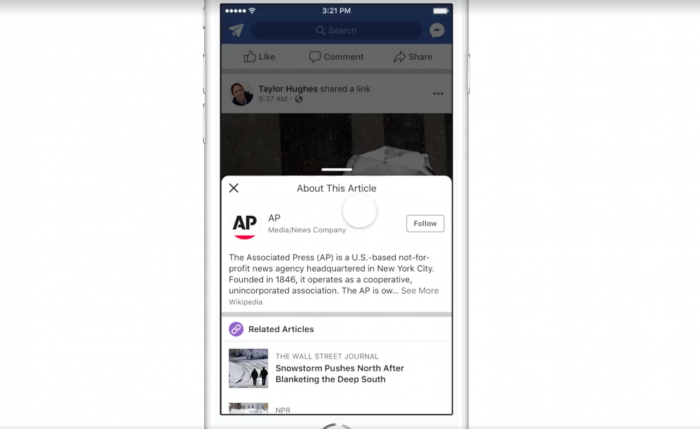
Facebook is adding an additional information button to news articles surfaced in the News Feed that will let users click through to see (1) background pulled from the Wikipedia page about the publisher, (2) other articles recently posted by the publisher, and (3) a heat map of where in the world the article is being shared and which of the user’s Facebook friends have shared it.
“When a publisher does not have a Wikipedia entry, we will indicate that the information is unavailable, which can also be helpful context,” Facebook said of the feature. (I’m not sure what helpful context is provided here for smaller, hyperlocal outlets without Wikipedia pages. One can also imagine a small outlet not yet given the Wikipedia treatment, that shares a name with a larger outlet elsewhere in the world, might be misidentified.)
Also recall that the Google-owned YouTube got itself into some trouble when its CEO Susan Wojcicki said at SXSW in March that it would add “information cues”/links to Wikipedia articles to certain videos, but Wikipedia said it wasn’t given a formal heads up about this plan.
This is an expansion of a test Facebook started running last October, with some input from partner publishers who are part of the Facebook Journalism Project. The feature is now rolling out to all publishers in the U.S. Facebook hasn’t specified a timeline for making this available in other countries, though it is “exploring the potential for this feature internationally,” the Facebook product designer and UX researchers behind this feature wrote in a separate Medium post on the design process:
More recently, we conducted fieldwork in Southeast Asia, showing how different local news ecosystems, news markets, and audience behaviors in Indonesia, Myanmar, and the Philippines led to different ways in which people approached gathering more information (for instance, relying more on social signals and comments). It was promising to find that in every market, people were excited to have a tool at their immediate disposal to provide more information about how they could understand the quality of any article.
Here are a few examples of how the feature operates in practice with U.S.-based publishers:
Interesting new “about this article” feature on Facebook news stories. It distinguishes news from satire, but is Wikipedia always a reliable source? pic.twitter.com/9XYSUB1LQ6
— Barbara Soderlin (@barbarasoderlin) April 4, 2018
Here’s how Facebook is using Wikipedia to fight fake news. A little “About this article” that links to the publisher’s Wikipedia page, along with some examples of other articles and which of your friends shared the story. pic.twitter.com/LE5Zr4wCYt
— Gene Park ✈️ PAX East, 4/6 (@GenePark) April 4, 2018
I guess Facebook’s grand bid to promote media literacy among users is…a blurb from a Wikipedia page about @nytimes? pic.twitter.com/WbLM8816iy
— Michael Roston (@michaelroston) April 4, 2018